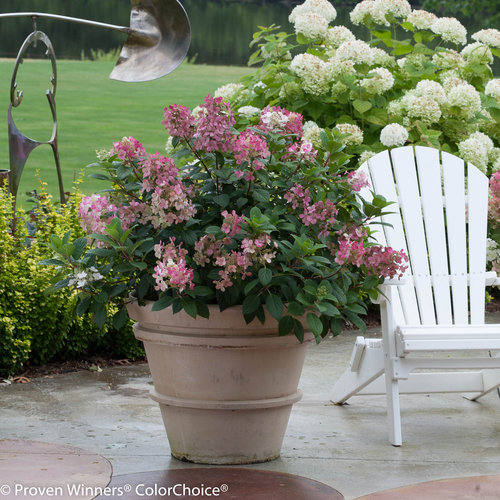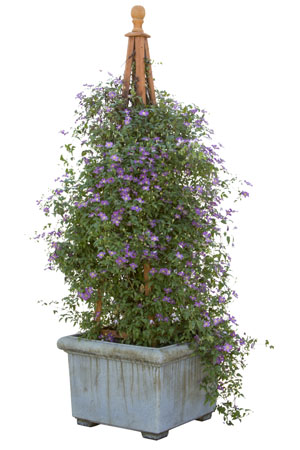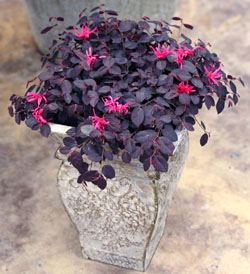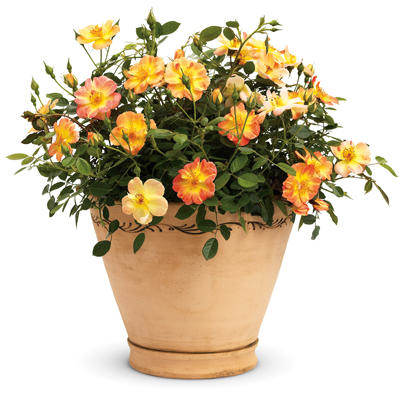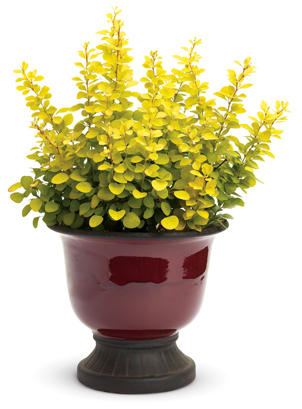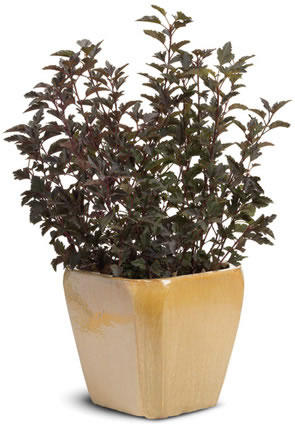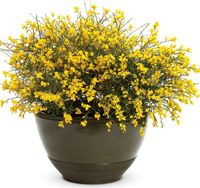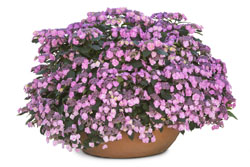Can I Grow Shrubs in Containers?
YES! It’s a great way to gain more garden space, and it’s something that we do frequently in our trial gardens to specially showcase new varieties. Best of all, it’s easy to do!
There are two ways to approach it:
TEMPORARY PLANTINGIn this case, you would plant a shrub in a container to enjoy for a few weeks to several months. For example, you might find a nice Show Off® Sugar Baby miniature forsythia at your garden center and plant it in a container surrounded by pansies, daffodils, PERMANENT PLANTINGIn this type of planting, you plant a shrub and maintain it in the same container for several seasons, serving as a year-round accent on your deck, patio, or porch. You can grow any shrub like this, provided that it is hardy where you live. This is because the shrub MUST spend winter outdoors. It may seem like bringing it indoors to protect it from cold would be good, but in fact, the plant needs the fresh air and strong light of the outdoors in order to grow properly. If the area where you want to keep it is exposed to exceptionally harsh weather, such as on a rooftop garden or a high balcony, it’s a good idea to select plants that are one or even two zones hardier than where you live. THE CONTAINERFor permanent shrub plantings, the container you chose must be weatherproof; that is, it must be made of a material that will not break, crack, or flake when left outdoors over winter. This usually means that clay, terra cotta, and ceramic containers are off-limits. Most other materials are fine. The container also must be large enough to accommodate the plant with room to grow into. Typically, this means containers that are 16"-24" (40-60 cm) diameter and proportionally deep. Small containers dry out quickly and become very difficult to maintain. In temporary plantings, you can use any type of container, since you will remove the plant before winter comes. Container size isn’t that important, either. It needs only be large enough to hold all of the plants you want in your design. SOIL AND FERTILIZERFor both temporary and permanent plantings, use standard bagged potting soil. Potting soil is lightweight, drains quickly, and fosters healthy, vigorous root growth. Permanent plantings will use up the fertilizer in potting soils after the first season, so plan to apply a granular fertilizer formulated for flowering shrubs (like a rose fertilizer) in early spring, when the soil thaws. WATERWater is important in both types of plantings, but is especially important in permanent plantings. As the plant grows, its water needs will increase. Containers can dry out quickly in hot, sunny weather, too. You may want to consider a drip irrigation system or use self-watering containers. Hand-watering can be sufficient, but you’ll need to schedule time to check your container daily and water it thoroughly. MAINTENANCEFor temporary plantings, carefully remove the shrub and plant it in your landscape at least six weeks before the ground freezes. Permanent plantings benefit from a layer of shredded bark mulch over the root zone year round, but especially in winter. When spring arrives, wait until the buds begin to appear on the stems, then carefully remove any wood that does not show signs of life. Permanent plantings will last, on average, 3-5 seasons, depending on the variety, the pot size, and your climate. Stunted growth and flowering indicate that it’s time to transplant into the landscape or into a larger container. WINTER CONSIDERATIONSAs long as your shrub is hardy in your area and your container is weatherproof, you don’t need to do all that much more to get your planting winter-ready. A 2-3” (5-7.6 cm) thick layer of shredded bark mulch will help regulate soil moisture. Alternatively, you can place cut branches from evergreens, like spruces, pines, and arborvitae, into the soil all around the base of the plant for protection. In areas where the soil does not freeze, you should check the soil every two weeks or so: it should be neither bone-dry nor soggy. Cold climate gardeners should check soil moisture if warm weather causes the soil to thaw before spring. When spring finally returns, it presents the perfect opportunity for you to assess your plant’s health and appearance and decide if it can spend another season in the same container, or if it should be planted into the ground or a larger pot. |
Jazz Hands® Mini chinense fringe-flower
|



